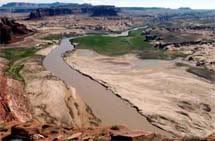The Pak Tribune reports:
Global warming will permanently change the climate of the American Southwest, making it so much hotter and drier that Dust Bowl-scale droughts will become common, a new climate report concludes.
While much of the nation west of the Mississippi River is likely to get drier because of the buildup of greenhouse gases in the atmosphere, the greatest effect will be felt in the already-arid areas on both sides of the US-Mexico border. By the end of the century, the climate researchers predict, rainfall in that region will have declined by a worrisome 10 percent to 20 percent annually.
A similar drying out of the subtropical belt above and below the equator will hit the Mediterranean region and parts of Africa, South America, and South Asia, the report says, as the overall warming of the oceans and surface air transforms basic wind and precipitation patterns around the earth.
The prediction of a drier Southwest was made by 16 of 19 climate computer models assembled by the Intergovernmental Panel on Climate Change, the international scientific effort to assess the impact of global warming, which is releasing a new report today. The drought results were analyzed separately in a paper published on line yesterday by the journal Science, which also predicted that regions outside the drying belt will get more rain.
"It's a situation of the poor getting poorer and the rich getting richer when it comes to rainfall," said Yochanan Kushnir of the Lamont-Doherty Earth Observatory of Columbia University, one of the paper's authors.
He said the authors of the new paper had a very high level of confidence that the droughts will develop and that they will be the result of increases in atmospheric greenhouse gases created through burning fossil fuels and other human activities.
The researchers said future droughts in the affected regions will be different from those in the past, which were caused by local weather conditions and the effects of El Niqo and La Niqa ocean temperature variations. The Southwest has seen significantly below-average rainfall since 1999, and there is some preliminary information to suggest that global warming is already playing a role .
As the planet warms, the researchers said, basic climate dynamics will change. Currently, hot air from the equatorial tropics rises about 8 to 12 miles until it hits the stratosphere and is blocked, then spreads to the north and south and remains aloft until it passes 10 to 30 degrees latitude before cooling and descending again. The computer models show that with more carbon dioxide and other greenhouse gases making the planet hotter, the area where the hot air remains aloft -- and suppresses rainfall -- will widen. Dry areas will become drier, and arid areas will expand.
The prospect of a drier Southwest is particularly troublesome because the region has some of the nation's fastest growing cities, including Las Vegas and Phoenix.
Richard Seager, also from Lamont-Doherty and a lead author of the paper, said the region will have to rethink how it uses water. Governments "need to plan for this right now, coming up with new, well-informed, and fair deals for allocation of declining water resources," he said.
The climate models generally assumed a gradually increasing amount of carbon dioxide in the atmosphere until 2050, at which point they assume that the nations of world will have found ways to replace fossil fuels as the main source of energy. Because climate responds steadily but slowly to the buildup, however, the full effect on precipitation changes would not be felt until 2100.
The changes are already in progress and will not be stopped for decades even by dramatic reductions in greenhouse gas emissions, the researchers said.
The current drought that has affected much of the Southwest since 1999 may already be the result of global warming as much as regional weather patterns, they said. For example, Kushnir said, the drought continued last year even though there was a significant El Niño effect -- which normally produces increased rainfall in the area.
Scientists have debated whether the increased dryness projected is a function of greater evaporation as a result of hotter temperatures or of decreases in rainfall. The broad consensus from the 19 new climate models blames decreased rainfall, Kushnir said.


No comments:
Post a Comment